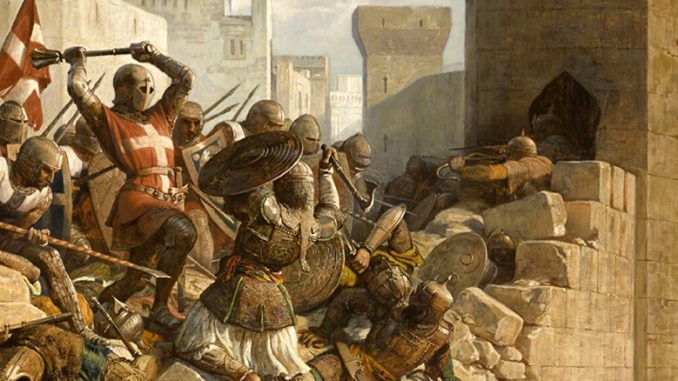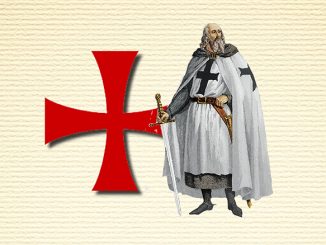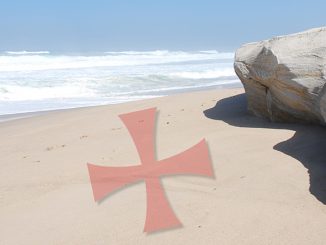
The following article on the Fall of Acre appeared in the Winter 2002 (Vol. 1 No. 2) issue of Templar History Magazine.
Fall of Acre – Overview
The article discusses the fall of Tripoli and the Fall of Acre during the Crusades. It covers the disputed succession, the battles, the sieges, and the ultimate conquest by Muslim forces. The Templars play a prominent role, but are blamed for the loss of the Holy Land.
Fall of Acre – Part 1
With the death of Bohemond VII in October of 1287, the rightful heir apparent of Tripoli was Bohemond’s sister, Lucia, who resided in Italy. The leaders of the area wanted no part of an absent leader and offered the helm to Sibylla of Armenia, who accepted and tried to install Bishop Bartholomew, whom the Templars held in great contempt for earlier political reasons. While this decision of the rightful heir met with strong objections from local leaders and merchants, she would not back down. The people of Tripoli decreed that the royal line was deposed, and Tripoli would be a commune, as was the case in Acre.
Sometime in 1288, Lucia arrived in Tripoli to assert her claim on the land, and the new commune did not want to relinquish its newfound power of self-rule. The leaders petitioned the Genoese to make Tripoli a protectorate. This was well received by the Genoese, as they welcomed the addition of an important trading partner. Warships were immediately dispatched to defend the city from any forces Lucia might send.
The Venetians backed Lucia, and the Templars backed their allies, the Venetians. Many of the Templar ships had been built by the Venetians. Soon after, a mysterious envoy of Christians arrived at the door of Sultan Kalaun in Egypt, requesting that he intervene in the turmoil that was brewing in Tripoli. The envoy was mysterious in that the names of those in attendance are not recorded in history, although some historians suggest that the Templar Grand Master and certainly the secretary of the order were aware of who they were. The argument of the mysterious envoy was that if the Genoese gained control of Tripoli, Egyptian trading in Alexandria would be seriously impaired. This met with great approval in the court of Kalaun, as he was looking for an excuse to break his treaty with the city. Although the Templar Grand Master was certain of Kalaun’s motivations, he could get no serious audience in Tripoli, where everyone seemingly had an unswayable faith in the treaty with Kalaun.
Fall of Acre – Part 2
In March of 1289, de Beaujeu’s words were finally accepted, but it was far too late; some 10,000 Muslim soldiers had surrounded the city. The Venetians and the Genoese, who had galleys, were ready to quickly evacuate their people to Cyprus.
Tower after tower soon fell to the steady beat of Muslim war drums as catapults pelted the walls with volley after volley. The Venetians were the first to flee, soon followed by the Genoese, both taking all the supplies their galleys would hold. The remaining citizens were paralyzed with fear as the ships had left to sea, taking their only visible means of escape.
When news of the exodus reached the ears of Kalaun, he moved with great haste as he knew that the Italians would load their galleys with the richest of materials ahead of their own people. He had desperately wished to plunder the city of its merchandise. Thus, he ordered an immediate assault to halt the further transshipment of goods.
As the Muslim army stormed the walls, they were met with only mild resistance, since Almaric of Cyprus fled the city with four galleys loaded with his own army, the Templar marshal de Vanadac, and Lucia. The Templar de Modaco was left in charge of the remaining Templars and was slaughtered along with the few remaining Christian forces trying to save the city from a much larger army. When those fighting in the streets were killed, the armies of Kalaun began going house to house, killing the men and sending women and young boys off in shackles to be sold as slaves. When the city was occupied, they set off to do the same on a small island where some had fled in small fishing boats.
After all was said and done, Kalaun ordered the walls of the city leveled, and Tripoli effectively ceased to exist. The Templars were devastated, having lost a sizable contingent of men they could scarcely afford to lose, especially in light of events to come.
Back in Acre, the citizens were in shock at the loss of Tripoli. They had falsely assumed that their trading status with the Muslims was as good a position of safety as any army could be. King Hugh immediately dispatched word to the Pope and the collective monarchs of Europe for military support. The support was not forthcoming, and the collective opinion was that there was not a strong enough need for a new crusade to defend the Holy Land.
Support did eventually come in the form of a ragtag army of mercenary soldiers made up of unemployed Italians and peasants. Since the Venetians had a vested business interest in Acre and an excellent fleet of ships, they transported the unskilled and untested army to Acre.
Disenfranchised that no pay was forthcoming for their efforts, the untrained army began to rob the citizens and steal from the merchants. One morning, a street fight broke out between the soldiers and a group of Muslims. History does not record the nature of the fracas, but it soon led to a full-scale riot as more and more people took sides in the fight. At the end of the day, many Muslims lay dead, and the families of the slain wanted revenge and justice.
An envoy of the mourning left Acre for the court of Kalaun. On arriving, they were given an audience with the sultan, and each one, in turn, told his version of the tale, dropping the blood-soaked garments of their dead before the Muslim leader. Kalaun vowed justice and immediately set out to use all his resources to prepare every siege engine he could lay hands on and set his army out to mete out the needed punishment. Kalaun did not, of course, make this decision public and instead sent letters to the Christians demanding that the guilty be turned over to him for a proper trial.
Fall of Acre – Part 3
The Venetians, who had brought the army to Acre, were vehemently opposed to this. Their opinion was that it would reflect badly on them to simply turn the men over to the Muslims. Although long-time allies with the Venetians, the Templars took the contrary view and felt the men should be turned over to the sultan if peace was to be restored and Acre remain safe. De Beaujeu, the Grand Master of the Templars, knew the sultan’s motivations and was chastised by the Christians of Acre as being a coward. The citizens felt the Templars were more interested in protecting their growing financial interests and had given up their original role as protectors of the Christian faithful. In this sense, they felt the Templars had turned their back on Christ.
The Grand Master’s warning was not heeded, and letters were sent back to the sultan. These letters expressed deep regret for the unfortunate incident and laid the blame on those guilty Venetian soldiers and not on the Kingdom of Jerusalem as a whole. While the Christians were using political spin to save their hides, Kalaun was building a formidable war machine. As hammers struck wood, building more siege engines, word began to trickle through Outremer that war was afoot. To divert their attention from his true goal, Kalaun circulated a story that his war machine was destined for the Sudanese and Nubians, who were both late in their tribute payments.
De Beaujeu did not believe the deception for a moment and continued to warn Acre, but his warning again fell upon deaf ears. Since the Grand Master had not given his support to the Venetians over the surrender of the soldiers, the Venetians sought to get even by not lending their support to the Templars on the warnings.
The cards dealt by Kalaun were of little importance because by the time any decision had been made, Kalaun lay dead in his tent, never hearing the outcome of the Christians’ decision. This did little to stop the ultimate fate of Acre as a new player picked up the cards his father had dealt. Al Ashraf Khalil was ready to carry on what his father had begun. The siege engines were built, swords sharpened, and horse hooves shoed. Winter had fallen, so it was decided that the advancement of the army would wait until spring.
Meanwhile, the Christians at Acre were anxious to learn of the intentions of the new sultan and sent an envoy of one Templar, one Hospitaller, an Arab translator, and a secretary who would prepare any paperwork required to cut a new deal. As soon as they arrived, they were jailed, and word soon came back to Acre that they were dead. The dice had been tossed, and it didn’t look like good news was on the horizon.
Fall of Acre – Part 4
In the spring of 1291, the sultan’s army set out, and the citizens of Acre, who the previous fall had so chastised the Grand Master of the Templars for his cowardice, now begged him to save them from the coming army.
While the Templars held the largest force in Acre, and the Hospitallers also had a good-sized army, they were no match for the 160,000 men the Muslims were sending. This army consisted of 100,000 foot soldiers and some 60,000 horsemen. The Templars and Hospitallers, always ready to wage war, set out to make preparations for the coming battle. The Teutonic Knights, who also had a force in Acre, were politically ridiculed and embarrassed when their Grand Master resigned in fear of the coming battle. They were able to elect a new leader in time for the battle.
The Genoese loaded their vessels and left before the fighting started. Having nothing to gain from the war and not wishing to aid the rival Venetians, they saw no fit reason to stick around.
A great wall surrounded Acre at the time, supported by ten towers. While this would seem a secure fortification, it was only a temporary means of protection against the many siege towers and catapults the Muslims brought to tear them down.
Since the sultan did not send a fleet, the seaside was open to the Christians for supplies. One ship was quickly equipped with a catapult and set to sea to protect the city from any fleet that may come forth.
Fall of Acre – Part 5
On April 6th, 1291, the first volley from the catapults began and continued to rain down on the walls and towers day and night. As the battle raged on, the Templars quickly became fed up with their role as mere defenders. They had nearly two centuries of attack experience and didn’t like being on the receiving end of one. It was soon decided to launch an attack on the Muslims’ camp under the cover of darkness.
One evening, the St. Lazarus Gate quietly opened, and the silence was replaced with the hoofbeats of 300 Templar war horses tearing off into the Muslim camp. Unfortunately, the cover of darkness meant to provide cover did not provide the Templars with enough visibility to be effective. The horses tripped on tent ropes, and the fallen Templars were slaughtered where they stood, further depleting their forces, which were already vastly outnumbered by the enemy.
Ever the rivals, the Hospitallers set out to show the Templars how to do the job, and on another evening, they charged off under the cover of darkness from the St. Anthony Gate, which was in their quarter, to finish the job the Templars had started. This time, the Muslims decided to throw a little light on the issue and set brush afire. The Hospitallers, seeing there was no chance of success, beat a hasty retreat back through St. Anthony’s Gate, eating a little crow on the journey. Thus ended the nightly forays into the sultan’s camp.
With each passing day, the walls cracked a little more as volley after volley rang out of the Muslim catapults. By May 16th, one tower cracked, and the army was able to enter, forcing the Christians back to the inner wall of the doomed city. Clearly, they were losing valuable ground in their defense of Acre. Two days later, the sultan ordered all the kettle drums to sound, and the thundering beat of the advancement was disheartening to the trembling people of Acre. Khalil ordered the forces to storm the walls and deliberately attacked all sides simultaneously, further spreading and weakening the Christians’ defenses.
Fall of Acre – Part 6
With this attack came the death of the Grand Master de Beaujeu. As thousands of arrows were shot over the walls, one met the unprotected part of the Grand Master’s armor as he raised his sword. As he was carried away, the crusaders begged him to stay and press on. His response was that he could do no more, he was already dead. True to his own words, de Beaujeu died within the day from his fatal arrow wound.
As the battle waged on, the Hospitaller quarter was the first to be breached, and as the Muslims stormed the wall, the St. Anthony Gate was quickly opened, allowing more soldiers through. Soon after, the Hospitaller Grand Master received a wound but wished to fight on. He had to be forcibly removed by his men and was sent off to sea.
Seeing the writing on the wall, many began to flee. Almaric left in his vessels and took many nobles with him. Otto de Grandson, the Swiss leader fighting for Edward I, loaded his English army into Venetian vessels and set off to sea as well. The rank and file citizen fought over anything that would float and also set off to water.
As was the case in Tripoli, the men were killed, and women and young boys shackled as slaves. The elderly and infants were put to Muslim blades, and the army began to plunder the city. Those who could escape made their way to the Templar fort at the southernmost tip of the city, where there were about 200 Templars. Rather than flee themselves, they vowed to stay and protect the women and children who had sought refuge in the Temple. Of course, not all Templars were so valiant. Roger de Flor commandeered a Templar galley and offered safe passage to anyone with the prerequisite financial remuneration for the voyage.
Some five days passed as the Templars held the women and children in the safety of their fort. Annoyed that this one remaining building was obstructing the defeat of the city, Khalil sent an envoy to make a deal with the Templars. If they relinquished the fort, the lives of the women and children would be spared, and the Templars could take with them not only their weapons but all they could carry.
Peter de Severy, the commander of the last remaining Templar fortress in Acre, seeing no other possible solution to the stalemate, quickly agreed to the terms. The castle gates were opened, and the Muslims entered and hoisted the sultan’s banner, but contrary to the deal that had been made, quickly began molesting the women and young boys. This outraged the Templars, who obviously felt duped by the negated arrangement.
The doors of the castle were quietly closed, barred, and swords silently drew out of sheaths. In true Templar fashion, they slaughtered the attackers to a man. The sultan’s flag was hoisted down, and the Beauseant replaced. The battle was back on, and the garrison of Templars shouted that it would continue until their very deaths.
That evening, under the cover of darkness, Tibauld de Gaudin, the Temple’s treasurer, was escorted into the fort. He loaded the Templar treasure and as many women and children as he could back on his ship and set sail for the Templar castle at Sidon.
The following morning, the sultan sent an envoy to the fort, and they expressed their deepest regrets for the actions of a few guilty men. This was a similar situation that had once been offered to the sultan by the Christians to save Acre before the battle ever began. The envoy said that the sultan wished to meet with the commander of the fort to offer his personal apologies and to ensure that the surrender terms would be upheld this time.
De Severy, it seemed, had not learned the lesson earlier taught and selected a few Templars to accompany him on the trip to the sultan’s camp. Once the party was outside, they were brought to their knees and beheaded as their slack-jawed brother knights watched from the walls of the fort.
The sultan’s miners continued to work on the foundations of the fort, and when all was ready, they set timbers ablaze. As the walls began to crack, Khalil ordered a party of some 2,000 soldiers to storm the fort. The added weight of the attacking forces on the crumbling structure was too great, and the entire building collapsed, killing all who were inside and those who were trying to get inside.
Fall of Acre – Part 6
With the destruction of this last Templar stronghold, Khalil’s conquest of Acre was completed. Meanwhile, de Gaudin, the treasurer, received word that he had been elected the new Grand Master. He immediately loaded the treasury and set sail for the island of Cyprus, the main headquarters of the order and an island they had once purchased from Richard I. He vowed to send reinforcement troops, but these troops never surfaced.
As city after city fell to the Muslims, the Holy Land was slipping from the hands of Christendom. All that remained of the Templars in the Holy Land was their castles at Tortosa and Athlit. On August 4th, 1291, Tortosa was abandoned, and less than two weeks later, on August 14th, Castle Pilgrim at Athlit was left unoccupied. Thus ended Christendom’s hold on Outremer, and the Crusades were effectively brought to a close.
It is ironic that while the Templars were the last to give up the fight, they would be blamed for the Fall of Acre and the ultimate loss of the Holy Land. Accusations that would feed growing contempt for the order and see their ultimate demise at the hands of a king destined to capitalize on their growing unpopularity.
About Us
We hope you enjoyed this article about the Fall of Acre.
TemplarHistory.com was started in the fall of 1997 by Stephen Dafoe, a Canadian author who has written several books on the Templars and related subjects.
Read more from our Templar History Archives – Templar History



